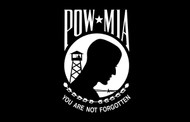Why the POW/MIA Flag Still Matters Today
Posted by Tim on Oct 15, 2025

More Than Just a Flag
If you’ve ever stopped and really looked at the POW/MIA flag, you know it feels different. The black and white, the stark silhouette, the haunting words “You Are Not Forgotten”—they stir something inside. This isn’t just a flag. It’s a reminder of real lives, real families, and the promise that we will never forget those who never made it home.
To veterans, it's a reminder of the brothers and sisters left behind. To families, it's a sign that their loved ones' sacrifices have not been forgotten over the years. To the rest of us, it's a reminder to remember.
A Flag Born From Sorrow
The flag's beginnings date back to 1971, in the middle of the Vietnam War. Families of missing troops were frantic for some means of reminding the country about those who had not come home. That's when Newt Heisley, a graphic designer and World War II veteran, came forward.
He relied on life experience—his own service, and watching his son fight health issues after training. The result was haunting: a man's silhouette, a guard tower, barbed wire, and words that speak directly to the soul: "You Are Not Forgotten."
This was never a design. It was a call to remembrance.
Voices Behind the Flag
"When I look at that flag, I'm reminded of my dad. He never returned from Vietnam. But knowing the country still flies that flag—it's a reminder to me that people haven't forgotten him."
— Daughter of an MIA serviceman
"For those of us who fought, it's not a piece of cloth. It's our brothers and sisters who didn't come back. When I see it, I salute—not the flag, but them."
— Vietnam veteran
"It means hope. As long as that flag is flying, there's hope that someone, somewhere, remembers."
— Spouse of a POW
These voices say to us: the POW/MIA flag is not abstract. It's deeply personal.
Why It Still Matters Today
1. A Promise Kept Alive
The flag is a national vow: no one will be left behind. It makes a promise to families that their sacrifice is not for nothing, and it keeps missing servicemen and women alive in the nation's heart.
2. A Symbol of Unity
In a world divided by strife, the POW/MIA flag is above politics. It's about people, love, sacrifice, and honor. It unites Americans under one simple ideal: freedom isn't free.
3. A Connection Across Generations
Later generations may not know the details of Vietnam or other wars, but observing the flag—and finding out the tales thereof—educates them about sacrifice, valor, and honor.
Where It Flies
The POW/MIA flag is one of the only flags to have flown over the White House. You'll also see it flying over the U.S. Capitol, the Pentagon, veterans' hospitals, national cemeteries, and hundreds of small-town courthouses. On National POW/MIA Recognition Day—the third Friday in September—it takes center stage, but for many, it never comes down.
Final Reflection: You Are Not Forgotten
The POW/MIA flag is a symbol, but it is so much more than that—it is a promise. It is heavy with love and loss, waiting families, remembering veterans. It is a reminder that freedom is never free, and those who gave the ultimate sacrifice will never be forgotten.
So the next time you see that black-and-white flag fluttering in the wind, take a moment. Consider the names, the faces, the families. And remember: they are not forgotten.
Carry the Legacy Forward
If this flag speaks to your heart as profoundly as it speaks to ours, consider making it a part of your home, your business, or your community. Flying the POW/MIA flag is more than display—it's a promise to remember.
Shop POW/MIA Flags Here and keep the legacy alive.
